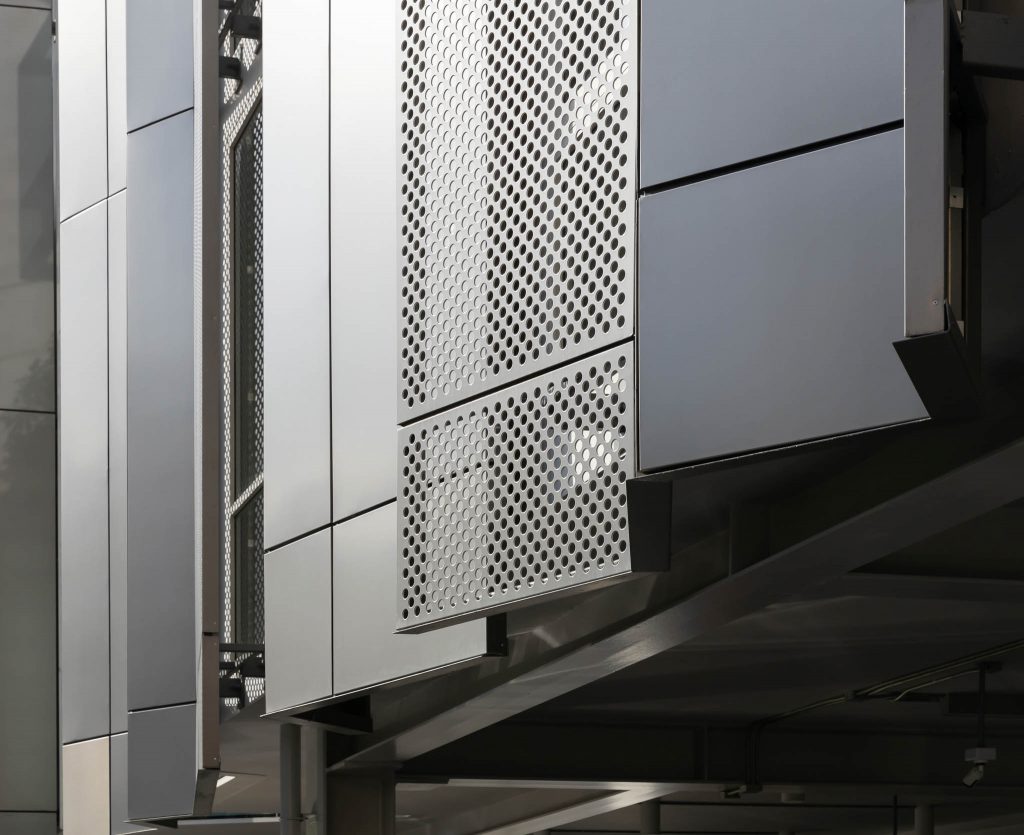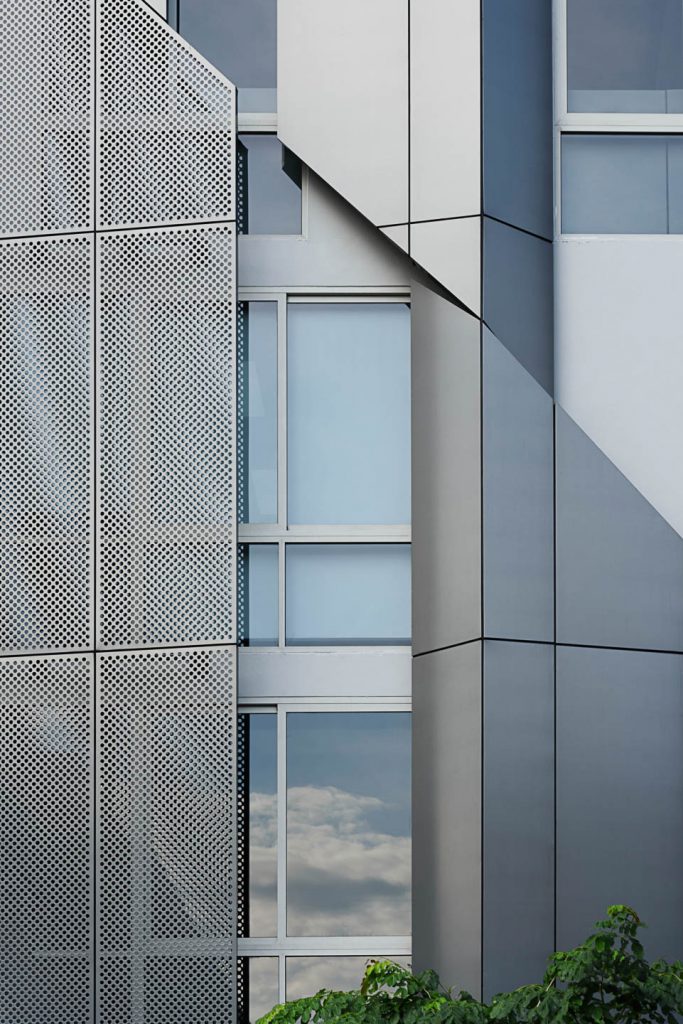IDIN Architects has designed a mixed-use building with an eye-catching façade, using glass and aluminum panels to conceal different functional spaces and to create more diversified perspectives.
Text: Warut Duangkaewkart
Photo: Ketsiree Wongwan except as noted
Download the online journal Issue 02 More Than Skin Click here
ในแง่มุมของงานสถาปัตยกรรม หลายครั้งเราแบ่งแยกอาคารต่างๆ ด้วยรูปลักษณ์ภายนอกของอาคารที่แตกต่างออกไปตามยุคสมัย ตามความนิยม และการใช้งานของแต่ละช่วงเวลา นอกจากนั้นสถาปัตยกรรมยังบ่งบอกถึงแนวความคิดที่เป็นตัวขับเคลื่อนความเป็นอยู่ในยุคนั้นๆ จนถึงปัจจุบันที่หลากหลายแนวความคิดถูกนำ มาประยุกต์ใช้ร่วมกันเพื่อแสดงออกถึงเอกลักษณ์ของงานสถาปัตยกรรม ในขณะเดียวกันด้วยองค์ความรู้ที่หลากหลายมากขึ้น การออกแบบยังต้องช่วยตอบโจทย์ในแง่มุมที่ต่างออกไป ทั้งในเรื่องของการใช้งาน บริบทของพื้นที่ตั้ง ความเชื่อส่วนบุคคล หรือ การแสดงออกในเชิงธุรกิจ ที่เป็นปัจจัยเข้ามาทำให้แต่ละอาคารมีความแตกต่างกันออกไป
Suan Phlu 9 Office เป็นงานออกแบบโดย IDIN Architects ตั้งอยู่ในชุมชนซอยสวนพลู 9 ซึ่งเป็นหนึ่งในเขตที่อยู่อาศัยสำคัญใจกลางกรุงเทพมหานคร ทิศตะวันตกเฉียงใต้ของที่ดินติดกับศาลเจ้า ที่เป็นเสมือนพื้นที่เปิดโล่งสำหรับชุมชนละแวกนี้ นำมาสู่โจทย์สำคัญที่ทำให้ IDIN คำนึงถึงบริบทของพื้นที่ในช่วง เริ่มต้นของการออกแบบ ด้วยความตั้งใจที่อยากให้อาคารทำหน้าที่เป็นฉากผืนใหญ่ ผนวกกับการเพิ่มพื้นที่สีเขียวให้กับพื้นที่โดยรอบในลักษณะ Vertical Garden เปลือกของอาคารหรือ Façade จึงเป็นสิ่งแรกที่ถูกคำนึงถึงในการออกแบบของโครงการนี้

Photo: Ketsiree Wongwan
จากโจทย์ที่ได้รับให้ออกแบบอาคารสำนักงาน และที่อยู่อาศัยสำหรับครอบครัวใหญ่ ด้วยฟังก์ชั่นทั้งหมด อาคารถูกออกแบบให้มี 8 ชั้น โดยชั้นล่างเป็นส่วนต้อนรับ และที่จอดรถใต้อาคาร ส่วนชั้นที่ 2 – 4 เป็นสำนักงาน และ ด้านบนเป็นที่อยู่อาศัยทั้งหมด ซึ่งในการวางผังอาคารผู้ออกแบบได้ทำงานร่วมกับซินแสในการจัดวางห้องต่างๆ เพื่อให้เป็นตามหลักการฮวงจุ้ยที่เหมาะสม ที่ดินทั้งหมดถูกแบ่งออกเป็นผัง 9 ช่อง ทำให้ฟังก์ชั่นบางส่วนต้องถูกจัดวางด้านทิศตะวันตกเฉียงใต้ ที่จะเป็นฉากหน้าอาคาร จนเกิดเป็นจังหวะของการใช้งานที่แต่ละชั้นเริ่มมีความแตกต่างกัน บวกกับอีกหนึ่งโจทย์ที่สำคัญคือวัสดุในการก่อสร้างที่เจ้าของโครงการต้องการให้ใช้เหล็กในการออกแบบ เพื่อให้แสดงถึงภาพลักษณ์ของกิจการด้วยอีกทางหนึ่ง จึงเป็นสิ่งที่เข้ามาส่งเสริมแนวความคิดในการออกแบบเปลือกนอกอาคารให้ใช้ประโยชน์ในการออกแบบ โดยมี Curtain Wall เป็นรากฐานของไอเดีย ที่จะถูกนำมาออกแบบในลักษณะของ Double Façade ซึ่งในเรื่องของการใช้กระจกเข้ามาเกี่ยวข้อง ยังต้องคำนึงถึงสิ่งที่จะเกิดผลกระทบต่อพื้นที่โดยรอบด้วย เนื่องจากการใช้ผนังกระจกที่อาจจะสะท้อนแสงแดดออกไปยังชุมชนโดยรอบ ประกอบกับการที่ฉากใหญ่ของอาคารนั้นตรงกับทิศตะวันตกเฉียงใต้ ที่จะต้องรับแสงอาทิตย์โดยตรง ทำให้เปลือกอาคารที่ออกแบบยังต้องทำหน้าที่คอยกันแสงแดด และความร้อนที่จะเข้าสู่พื้นที่ภายในอาคารด้วย
ด้วยความต้องการของสถาปนิกที่จะทำให้เปลือกอาคารตอบโจทย์ที่หลากหลายนั้น รูปแบบความคิดในการพัฒนาจึงเกิดเป็นลำดับขึ้นตอน จากแนวความคิด สู่การแก้ปัญหา ตั้งแต่จุดเริ่มต้นที่ต้องการสร้าง Vertical Garden เพื่อลดทอนงานระบบที่จะเกิดขึ้น และสร้างมุมมองที่เปิดโล่งสำหรับพื้นที่ภายในอาคาร Façade ถูกแบ่งออกเป็นส่วนๆ เพื่อสลับการใช้งาน ในส่วนที่เป็นพื้นที่ใช้สอยผู้ออกแบบเลือกที่จะปิดบังอาคารบางส่วนด้วยการใช้กระจก และแผ่น Aluminum ทั้งแบบที่เป็นแผ่นทึบ และแบบเจาะรู (Perforated) ทำให้เกิดมุมมองที่ต่างกันออกไป ส่วนของกระจกให้ความโปร่ง 100% เพื่อที่จะรับแสงธรรมชาติ และเปิดมุมมองจากภายในสู่ภายนอก ส่วนแผ่น Aluminum แบบเจาะรูเป็นการเปิดมุมมองแบบ 50% ที่ช่วยกรองแสงบางส่วน แต่ยังสามารถรับความสว่างเข้ามาได้ และแผ่น Aluminum แบบทึบจะช่วยปิดบังการใช้งานบางส่วน และลดความร้อนที่จะเข้าสู่ตัวอาคารโดยตรง
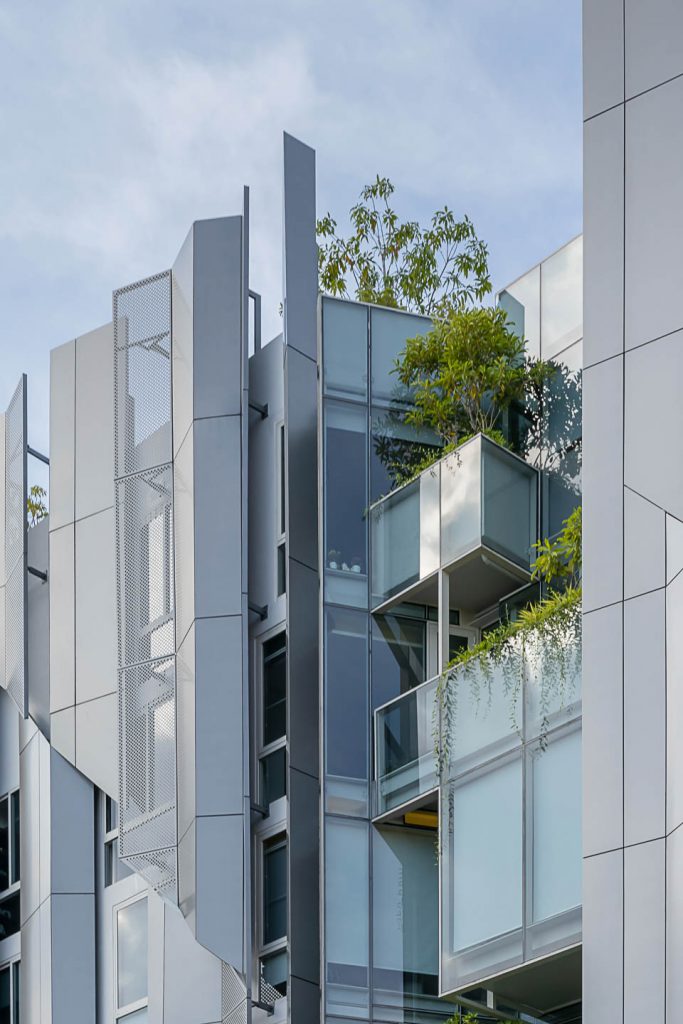
Photo: Ketsiree Wongwan
อีกส่วนสำคัญของการออกแบบ Façade คือการเพิ่มพื้นที่สีเขียวที่เป็นแนวความคิดแต่แรกเริ่ม จากการใช้งานแบบเต็มพื้นที่ สถาปนิกเลือกที่จะคว้านพื้นที่บางส่วนของตัวอาคารออก เพื่อให้เกิดเป็นเส้นของพื้นที่สีเขียวที่ไล่ระดับไปตั้งแต่ชั้นล่างจนถึงด้านบน ซึ่งออกแบบให้ต้นไม้ถูกปลูกในกระถาง และ เติบโตลงไปด้านล่าง เพื่อให้ง่ายต่อการดูแลรักษา ในลักษณะนี้นอกจากมุมมองด้านนอกแล้ว ด้านในอาคารจะมองเห็นพื้นที่สีเขียวที่แทรกตัวอยู่ในทุกๆ ชั้น ทำให้พื้นที่สีเขียวที่ถูกออกแบบนั้นเกิดประโยชน์อย่างแท้จริง สำหรับผู้ใช้งาน และบริบทของชุมชน ที่ไม่ใช่เป็นเพียงเปลือกอาคารเพียงอย่างเดียว โดยในขั้นตอนการออกแบบนั้น สถาปนิกใช้วิธีการออกแบบจากมุมมองของพื้นที่ภายในทีละชั้น เพื่อให้เห็นภาพของสิ่งที่จะเกิดขึ้นในแต่ละพื้นที่ใช้สอยของอาคาร และ ความเชื่อมโยงของช่องเปิดต่างๆ ทั้งที่เปิดโล่ง กึ่งโปร่ง และปิดทึบ รวมถึงเอฟเฟคเมื่อต้นไม้เริ่มโตขึ้น หรือ ห้อยกิ่งก้านลงมา จะมีมุมมองอย่างไร

Photo Credit: IDIN Architects
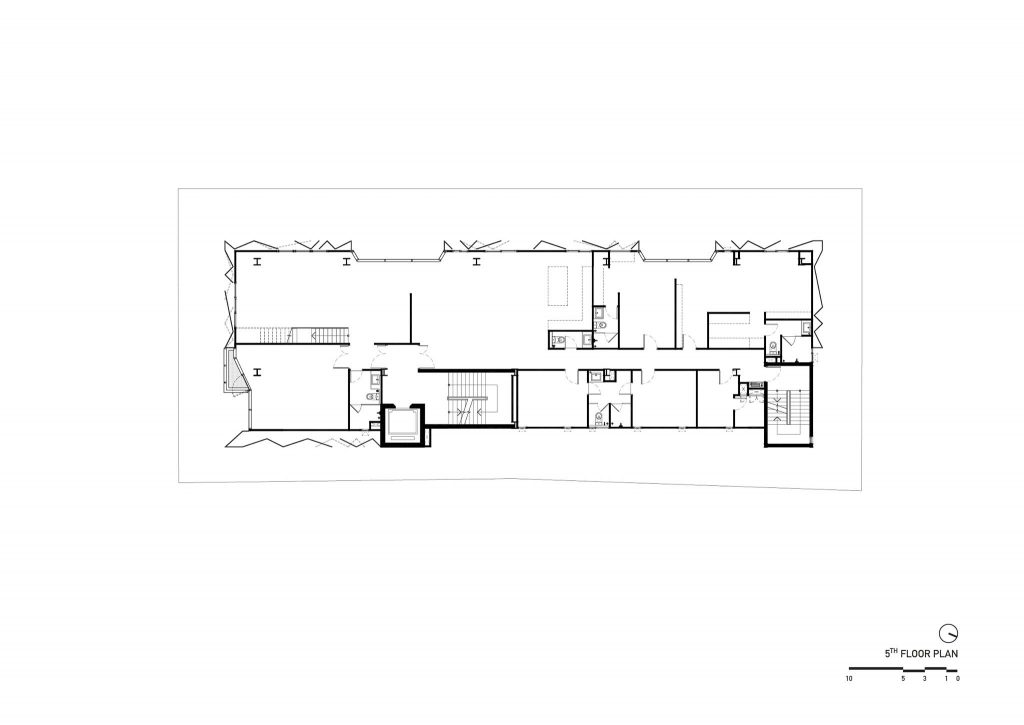
Photo Credit: IDIN Architects
เมื่อปัญหาโดยรวมจากบริบทต่างๆถูกออกแบบและแก้ไขในเบื้องต้นแล้ว อีกหนึ่งหน้าที่สำคัญของงานสถาปัตยกรรม คือการสร้างเอกลักษณ์ให้เกิดขึ้น ด้วยความที่เป็นอาคารสำนักงานที่มีกิจการของตัวเอง สิ่งนี้จึงถูกนำมาประยุกต์ และ พัฒนาต่อให้เกิดเป็นเอกลักษณ์ที่มีความเฉพาะตัว เริ่มต้นจากการที่ Façade ทั้งหมดถูกบิดแกน และพับไปมา เพื่อให้เกิดเป็นพื้นผิวที่ไม่นิ่งจนเกินไป อีกทั้งยังช่วยให้พื้นผิวต่างๆ มีมิติที่รับความร้อนแสงแดดได้แตกต่างกัน เกิดเป็นจังหวะของ Façade โดยรอบ ถึงแม้ว่าแสงแดดจะส่องลงมากระทบผนังในทิศทางเดียวกัน องศาของวัสดุจะช่วยให้เกิดเป็นโทนสีที่หลากหลาย ตามแสงและเงา พร้อมกับเพิ่มลูกเล่นเพื่อสร้างความน่าสนใจ ด้วยการทดลองเฉือน Façade ออกตามแนวเฉียง ทำให้ วัสดุของรูปด้านอาคารทั้งหมดเลื่อนและเหลื่อมกัน จนเกิดเป็นเส้นสายของอาคารที่แสดงออกมาอย่างชัดเจนในทันทีเมื่อพบเห็น ตามความตั้งใจของเจ้าของโครงการ
IDIN Architects พูดถึงแนวความคิดของการออกแบบงานสถาปัตยกรรมไว้ว่า ในหลายครั้งรูปลักษณ์ของอาคารไม่ใช่เรื่องของสไตล์ของการออกแบบเพียงอย่างเดียว อย่างอาคารที่เห็นว่าเป็นรูปแบบโมเดิร์นนั้น อาจจะมีแนวความคิดที่ซ่อนอยู่เบื้องหลัง เป็นการนำงานออกแบบมาใช้ในการแก้ไขปัญหา ไม่ว่าจะเป็นเรื่อง Mass ของอาคาร Façade ที่มองเห็น หรือการวางผังที่แตกต่างออกไป ผสมผสานกับลายเส้นของแต่ละคน จนออกมาเป็นอาคารหนึ่งหลัง ซึ่งท้ายที่สุดแล้วการออกแบบอาคารไม่ใช่เพียงการสร้างภาพลักษณ์ให้สวยงาม หรือน่าสนใจเพียงอย่างเดียว แต่หากเรามองถึงที่มาของเส้นสาย รูปลักษณ์ วัสดุ และรายละเอียดต่างๆ อาจจะทำให้เข้าใจถึงที่มาของแนวความคิด ที่ซ่อนอยู่เบื้องหลังอาคารที่ถูกออกแบบมาได้
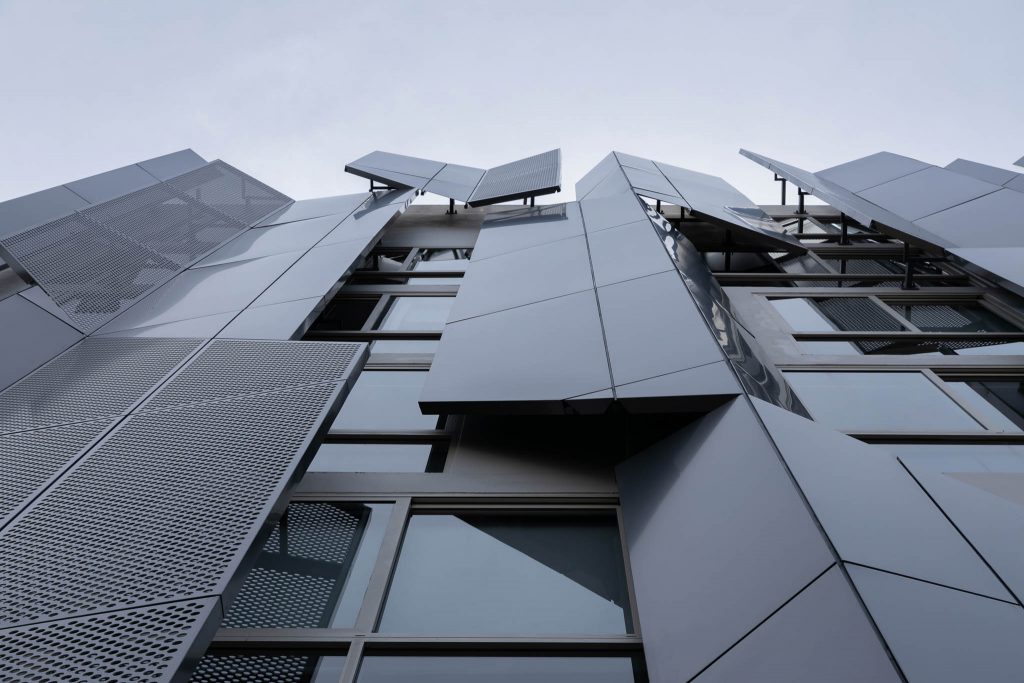
Photo Credit: Ketsiree Wongwan
From an architectural standpoint, we often categorize building types according to their appearances as well as stylistically defining structures by periods, popularity and functionalities. Architecture is also an indication of a particular tenet that mobilizes and shapes humans’ way of living at a particular point in time.
Nowadays, architects apply and devise different architectural concepts and beliefs to help express a work’s architectural identity. Meanwhile, the diversified and integrated bodies of knowledge have enabled design to better satisfy different requirements, ranging from functionalities, contexts to personal beliefs and business identities, each contributing to the varying characteristics of buildings.
Designed by IDIN Architects, Suan Phlu 9 Office sits as a part of Soi Suan Phlu 9 Community, a residential area in Bangkok’s city center. A Chinese shrine is located on the southwest of the land, which serves as somewhat a semi-public community space. The nature of the site plays a significant part in the early development of the design. The IDIN team intends for the building to exist as a community backdrop with a vertical garden bringing green space to the surrounding area. With such an idea in mind, they started the design development process with the building’s façade.
พื้นที่สีเขียวถูกแทรกเป็นส่วนหนึ่งของผิวอาคาร
Photo: Ketsiree Wongwanองศาของการออกแบบ Facade ทำให้เกิดแสง และเงาที่น่าสนใจ
Photo: Ketsiree Wongwanวัสดุทั้ง 3 ประเภทที่ช่วย สร้างความโปร่ง – ทึบให้พื้นที่ภายใน
Photo: Wotapas Dusadeewijai
IDIN’s design team was given the brief of designing an office/residential building for a large family who notes for all the required functionalities to co-exist into an eight-story structure. The first floor houses the reception area and underground parking. The office space occupies the 2nd-4th floors, while the remaining upper floors are home to the living quarter of all the family members. With consultation from a Feng Chui master, the floor layout locates rooms according to Feng Chui laws. The design divides the land into a grid of nine squares, causing parts of the functional spaces to situate towards the southwest, the same direction the façade faces. The layout creates a functional sequence that differentiates the functionality of each floor.
Another critical requirement is the use of steel to express and showcase the identity of the owner’s business. The material reinforces the design concept of the façade developed from the idea of a curtain wall before the design team decided on a double-façade structure as the final solution. The design takes the glaring effect of glass into serious consideration since the material’s physical attributes can reflect sun rays and disturb the surrounding community. In addition, the southwest-facing façade and its direct contact with the afternoon sun meant a requirement for the structure to have additional functionality to filter excessive sun rays and heat from infiltrating the interior space.
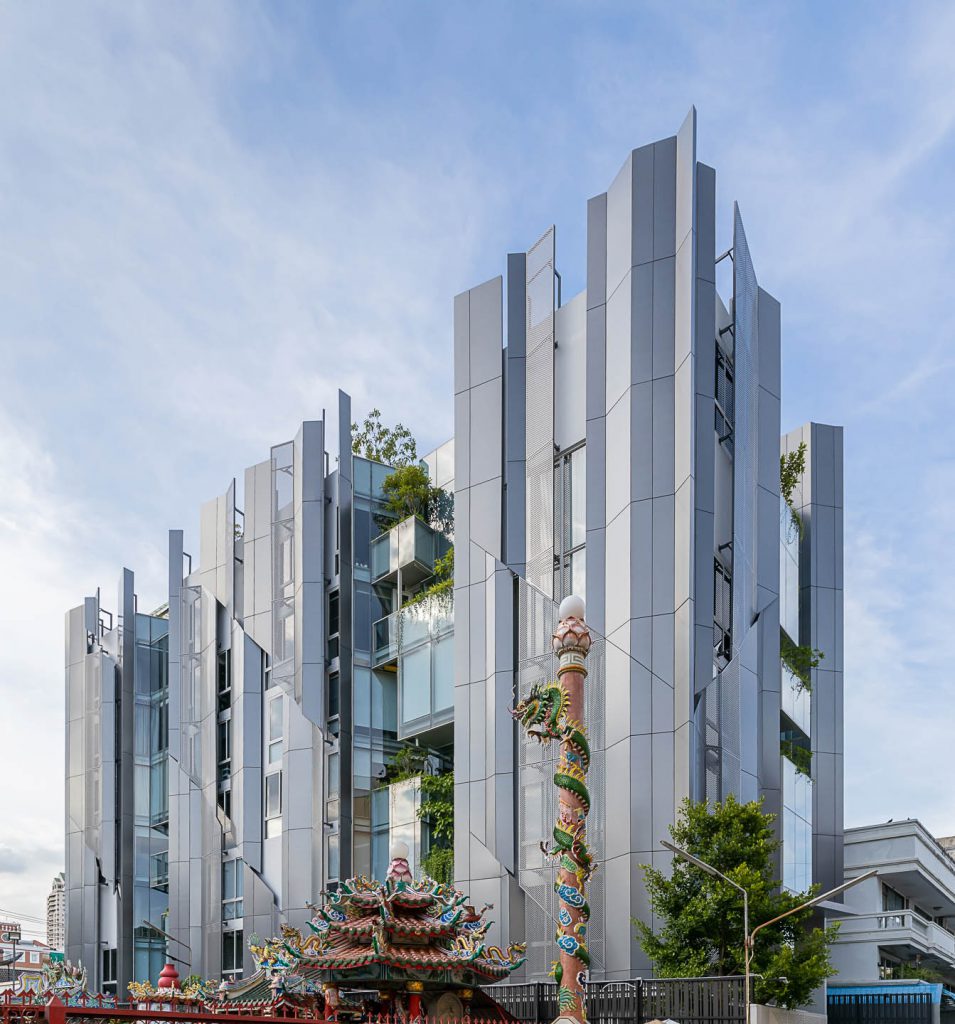
Photo Credit: IDIN Architects
The desire for the building envelope to fulfill all these requirements leads to a methodic development of ideas, from conceptualization to solutions. The process begins with the inclusion of a vertical garden as a part of the facade, since it can lessen the unnecessary system work and create a more open perspective for the interior spaces. The façade is designed for each part to function alternately. Glass panels and aluminum sheets (both solid and perforated) are used to conceal different functional spaces, creating more diversified perspectives. The glass openings’ 100% transparency welcomes natural light and opens the interior space to the outside view. The perforated aluminum sheets provide 50% visual access and help filter a considerable amount of sun rays while still allowing natural light to be present. The solid aluminum sheets offer complete density, which helps conceal certain parts of the interior spaces while simultaneously reducing external heat from penetrating into the interiors.

Photo Credit: IDIN Architects
Another essential element of the façade’s design is the green space, which was part of the design team’s initial idea. Instead of maximizing the usability of functional space, the architect decided to gouge out certain sections of the building and replace them with vertical green spaces, which descend from the bottom to the upper part of the building. The vertical garden comprises of potted climbing plants placed to crawl downward for easier maintenance. The design allows the green space to be visually accessible from the outside while still being an integral part of all the floors. As a result, the vertical garden benefits both the users and the surrounding community in other aspects beyond its functional and aesthetic merits as a building shell.
The architect develops the design from the perspective of a user, by visualizing the images the vertical garden brings to each functional space, as well as the connection between different openings and their varying levels of enclosure (fully open, semi-open and fully enclosed). The possible effects and changes in appearance have also been taken into account for when the trees and plants are fully grown.
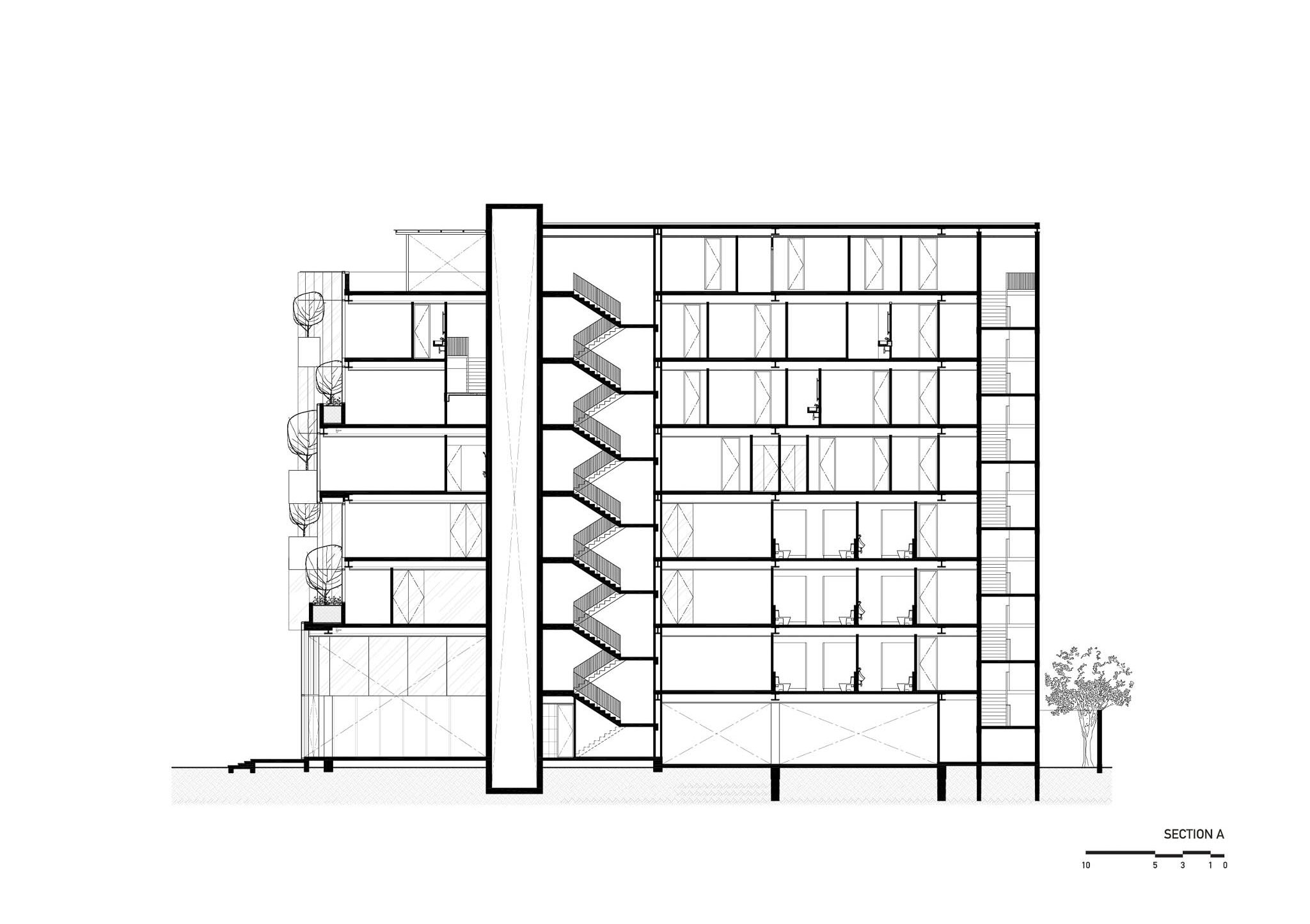
Photo Credit: IDIN Architects
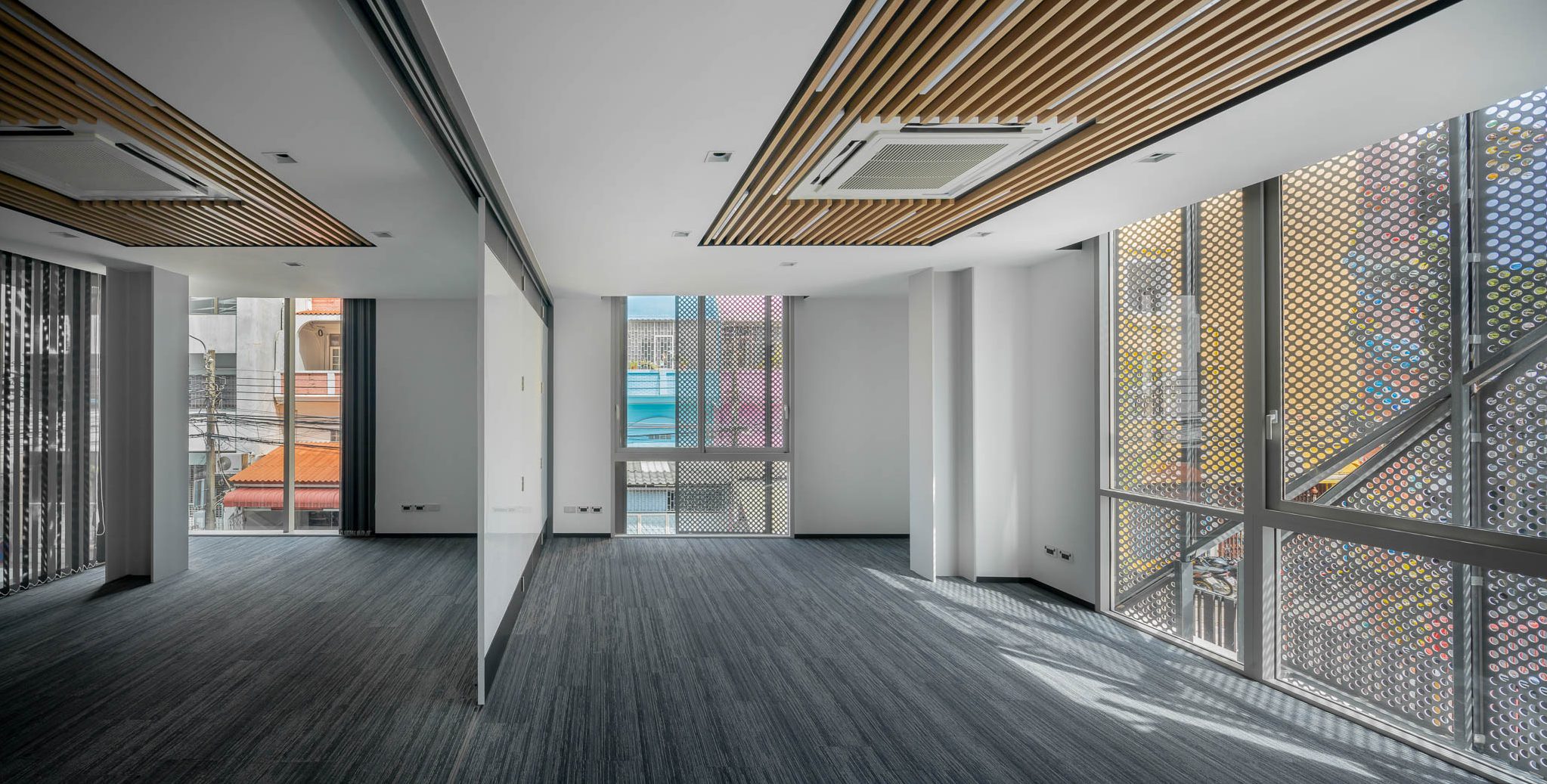
Photo: Ketsiree Wongwan
While the architectural design process helps reconcile the contextually derived issues, the architecture itself represents a specific identity. The character of the owner’s business is applied and developed to create architecture with its own identity. The twisting of the façade’s core axis and the folding of its entire mass renders a dynamic texture, creating a dimensional surface for varying levels of sun exposure. The physical rhythms of the façade react to natural light differently, causing the diversified angles to create various tones of colors. A diagonal cut of the façade results in the structure’s overlapping lines and silhouettes, creating a gimmick that brings an eye-catching element to the building, just like the owner intended.
IDIN Architects explains their view on architectural concepts and how the appearance of architecture does not always derive entirely from styles. Hidden behind modern-looking buildings are concepts, and design is a tool that architects utilize to help deliver the most fitting solutions. These may come in the form of the building’s mass, façade or layout. When combined with each architect’s unique architectural signature, these design solutions conceive a building, which holds more meaning than just a beautiful appearance. By examining the lines, form and visage, materials, and details, we can perhaps better understand the origins of concepts from which designs are materialized.



